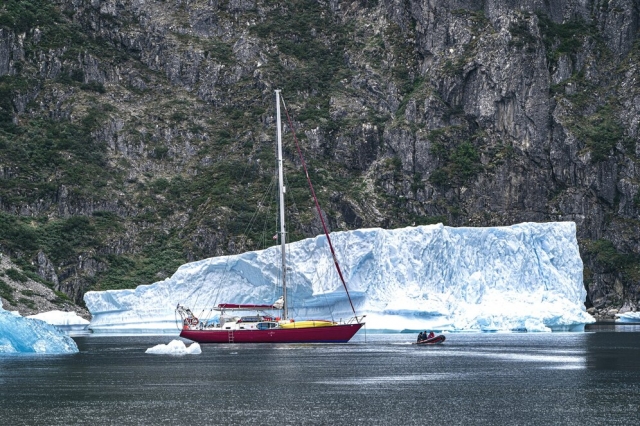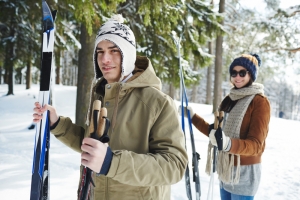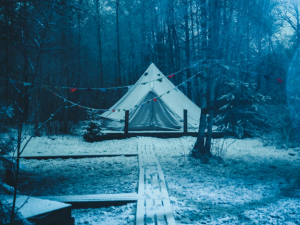Winterizing your boat during Wyoming's harsh winter season is crucial to protecting your valuable investment. The severe weather conditions of Wyoming can cause significant damage to your boat if not stored correctly.
Boats can be kept outside, but they're exposed to the elements. Damage including but not limited to cracks, engine damage, and seal leaks are common problems when boats are improperly stored during the winter. To prevent this, use quality covers and consider shrink wrapping for added protection.
Parking in a covered space offers further protection against the elements. Enclosed storage is the safest option, offering maximum protection against winter weather. However, these may come at a higher cost and require early reservation due to limited availability.
Lastly, regular maintenance, including thorough cleaning and mechanical care, helps extend the longevity of your boat. Draining all liquids, applying anti-freeze, and disconnecting batteries before storage can save you from costly repairs. Safeguard your boat in Wyoming's winter and it will be ready for smooth sailing in the spring.
Why Winterize Your Boat?
A key aspect of boat ownership involves correctly preparing your vessel for Wyoming's harsh winter conditions. Neglecting important measures such as winterization can result in costly and inconvenient damage.
Take engine care for example. Approximately 30% of boat owners in Wyoming do not change engine oil before storage, risking serious engine damage due to accumulated contaminants and moisture. It's in your best interest to break away from this statistic.
But why exactly should you be diligent about winterizing your boat? Below, we're shedding light on some key reasons:
- Preventing Engine Damage: Unattended engines can accumulate moisture and rust during the cold months. Regular oil changes before storage reduce this risk substantially.
- Fuel System Protection: Gasoline could destabilize over time, leading to serious fuel system problems. Using a fuel stabilizer protects your fuel system during winter.
Taking these precautions helps ensure your boat will be ready and waiting when you want to head back out onto the waters next spring.
Boat Storage Options
If you own a boat in Wyoming, proper winter storage is essential. Warm, indoor environments can prevent rusting and freezing - common issues during harsh winters. But, indoor boat storage facilities come with their own sets of considerations.
A factor to evaluate is the cost. Spending that extra buck can ensure your boat stays safe and ready for the next season. The average cost of indoor boat storage in Wyoming can range from $50 to $200 per month depending on the size and amenities offered by the facility.
"Investment in good storage pays off by extending your boat's lifespan."
Shop around before settling for a facility. Marinas, self-storage units, and specialized boat storage facilities are typical options to consider. Each boasts unique benefits depending on your needs and budget.
Ensure your chosen facility has optimal protection measures against theft or vandalism. Good security systems, surveillance cameras, and regular patrols are vital features to look for.
Preparing Boat for Winter
Winterizing your boat before the harsh Wyoming winter is crucial. This procedure safeguards your vessel from freezing temperatures and can significantly prolong its lifespan. A good start is to clean the boat thoroughly, both inside and out.
After a thorough cleaning, drain all water from the engine and replace it with antifreeze. Antifreeze prevents the motor's contents from freezing and cracking.
Over 60% of boat owners in the colder climates opt for shrink-wrapping their boats for winter storage as it offers protection from the elements. This trend highlights the importance of shielding your boat from wintry weather.
- Shrink-wrap your boat: Covering your boat using a thick, plastic film not only guards against moisture but also blocks harmful UV rays. It is flexible enough to fit any shape or size of a boat while providing strong and efficient protective covering.
- Remove all valuables: Theft can occur during the offseason. Ensure all expensive items, including electronics and personal possessions are removed from your boat.
- Maintain battery life: A disconnected battery preserves energy during storing period. Consider storing it in a warmer environment to avoid freezing.
The above are primary steps when winterizing your boat. In addition, consult with a professional to inspect other crucial components like the propeller, hull, and cooling system.
Effective Cleaning Practices
Winterizing your boat in Wyoming starts with thorough cleaning. Properly cleaning your boat before storage is significant in preventing potential damage that may occur during the harsh Wyoming winter.
Begin with a complete wash down using fresh water to remove salt and debris from all surfaces. This step prevents corrosion and hinges rusting over. Allow the boat time to dry thoroughly before proceeding to other cleaning steps.
- De-winterize the Engine: By flushing out the engine, you free it from any debris, ensuring it remains in good working condition throughout wintertime.
- Clean the Interior: Vacuum and wipe down all interior surfaces of your boat. This will prevent any mold or mildew buildup caused by trapped moisture.
- Apply a Protective Coating: Apply wax to all exterior surfaces of the boat. This coating protects your vessel from UV damage and harsh weather elements common in Wyoming's winters.
Practicing these effective cleaning methods not only preserves your boat's health but also reduces chances for unnecessary expenditures due to poor upkeep.
In terms of upholstery, use a vinyl cleaner for all vinyl areas and apply a conditioner afterwards to prevent drying and cracking. The conditioner also acts as a great barrier against potential mold growth.
Engine Preservation Techniques
To preserve your boat during Wyoming's harsh winter season, it's crucial to focus on the engine first. The engine is the heart of your watercraft; if it fails, your boat won't operate.
Your primary concern should be any leftover water in the engine. Water left in an engine over winter can freeze, causing extensive damage. Therefore, flushing out your engine and drying it thoroughly is a priority before storing it away.
Implementing Fuel Stabilizer
Avoid future fuel system issues by adding a fuel stabilizer. Mix it into the gas tank before the final run. This step prevents gum, varnish build-up and corrosion in the fuel system during storage.
Battery Storage Guide
Next, turn your attention to the battery. Disconnect, remove and store it in a cool, dry place - not on concrete to avoid energy draining. Make sure to periodically charge it during winter months.
Boat Cover Importance
Covering your boat with a designed boat cover is also essential to prevent potential damages from freezing temperatures and heavy snowfalls.
Remember: Boat theft rates often decline during the winter months, but approximately 10% of boat thefts occur while boats are in storage. Clearly emphasizing the importance of secure storage options for your vessel.
Secure Storage Choices
Prioritize places that provide secured indoor facilities with security systems in addition to basic protection from elements for ultimate safety of your investment.
Storing a boat safely during Wyoming's winter is not challenging if you follow these helpful techniques - every step matters in ensuring your prized possession's longevity.
Interior Protection Measures
The boat's interior is just as important to safeguard against Wyoming's harsh winter conditions. Prioritize thorough cleaning to prevent mildew and other damage. Remove all food, trash and valuables that could attract pests and rodents.
It's crucial for you to eliminate any existing moisture before storage because it can turn into mold or rust. Use fans, dehumidifiers, or other means to dry the boat completely. Ensure that the bilge is dry by running the bilge pump.
- Gather protective covers: Use special covers that are designed for boats, these will keep dust, dirt, snow and ice out.
- Remember ventilation: Proper ventilation prevents mold from growing. You can leave doors or hatches partially open, but make sure critters cannot enter your boat.
- Check heaters regularly: If you are using a heater in your boat ensure it's working properly throughout the storage period.
Battery preservation is vital too; it's advisable for you to disconnect and remove it. Store it in a warmer environment but remember to keep it charged.
Treating fuel tanks ensures they don't condense water during storage time. Full tanks with stabilized fuel tend to resist condensation better. This goes a long way in preserving your engine for the next season.
Plumbing and Pump Winterization
Winterizing your boat's plumbing system offers exceptional protection against harsh cold weather. Empty the pipes, tanks, and pumps to start. This precaution helps avoid the expansion of water inside these components that can lead to irreversible damage.
Drying Out Water Tanks
Tanks containing freshwater need detailed focus. It's crucial for you to drain all water and freeze-proof it. To do this, open the faucet furthest from the tank, then work your way back towards it, until all faucets have been opened and closed. This ensures any trapped water is removed.
Pipe Clearing Techniques
The correct clearing of your pipes speaks volume for their longevity. Utilize low pressure air or specialized non-toxic antifreeze formulated for marine use to push remaining water out from the pipes. This method eradicates residual moisture, minimizing risk of freezing damage.
Protect Your Water Pumps
Remember that your water pump is vulnerable to frost too. Completely draining it can be challenging as some models tend to trap pockets of water. 'Pickle' your pump with antifreeze after you've drained it; this process involves filling the pump housing with antifreeze in order to provide full protection.
Importance of Proper Storage
Your boat's safe winter storage prevents unnecessary cost on repairs once spring arrives. Always park your boat at an angle which facilitates drainage and cover it thoroughly using a specifically designed boat cover which can withstand severe winter conditions.
Fuel System Maintenance
During frigid Wyoming winters, it is vital to protect your boat's fuel system. Sub-zero temperatures can cause noticeable damage to the engine and hull if your boat isn't properly winterized.
A thorough cleaning of your fuel system is essential. Start by removing any residual water that could freeze and crack components, then apply fuel stabilizer. Don't let the tank be empty; a full tank reduces moisture accumulation.
Fuel maintenance steps and their benefits are summarized in the below table:
|
Steps |
Benefits |
|
Remove all Water |
Prevents freezing & cracking |
|
Apply Fuel Stabilizer |
Preserves fuel quality throughout winter |
|
Maintain Full Fuel Tank |
Reduces moisture buildup |
|
Always reference your boat's owner's manual for specific instructions. |
|
Your investment in maintenance today can save you costly repairs tomorrow. Carefully follow these steps to ensure your boat weathers the harsh Wyoming winters successfully.
Sails and Rigging Considerations
Your boat's sails and rigging demand substantial attention for off-season storage. Extreme winter conditions, typical in Wyoming, can intensify existing wear and tear on these crucial components.
Begin inspecting your boat by meticulously examining the lines, ropes, and sails on your boat. Look out for signs of stress like cuts, abrasions, or fraying which indicates a replacement is needed.
Persistent moisture is another factor contributing to the degradation of your rigging. If left unresolved throughout winter storage, this dampness can trigger mold growth or accelerate corrosion.
- Detach your sails: Sails should be removed from the mast for clean up and thorough drying before storing.
- Secure loose parts: Any removable parts like winch handles should be properly secured to prevent loss or damage.
- Cover all equipment: Covering all remaining gear will protect it from harsh weather elements, using specific protecting substances when necessary.
Around 25% of Wyoming's registered boat owners do not properly cover or shelter their boats during the winter. This neglect often results in potential weather-related damages such as cracking or upholstery issues.
You can significantly minimize future repair expenses by thoroughly inspecting, cleaning, and correctly storing your sailing equipment each winter season.
Spring Relaunch Preparations
Start preparing your boat for the warm spring season while it's still stored away.
This critical transition period calls for utmost diligence to prevent expensive repairs later.
Examine your engines and fuel systems for wear and tear, ensuring they're functioning optimally.
Inspect seals for potential leaks. It's easier managing them now than when water is involved.
Your hull's condition reflects how well you have implemented winter storage advice.
|
Action |
Reason |
|
Engine & Fuel System Check |
To avoid performance issues |
|
Seal Inspection |
To prevent possible leakages |
|
Hull Evaluation |
To gauge protection level during winter storage |
Incredibly, less than 20% of boat owners in Wyoming have their boats stay in heated indoor storage sites, despite providing the best security against extreme winter weather conditions. Although pricey, it guarantees the best preservation of your cherished boat.
All in all, protecting your boat during downturns goes beyond regular storage practices; it's an integral part of ensuring a smooth spring relaunch without unwelcome surprises.
Winter Boat Storage
Protect your boat during Wyoming's harsh winter by practicing essential storage strategies. Learn how to prevent damage, maintain cleanliness, and ensure longevity of your vessel with this comprehensive guide.






